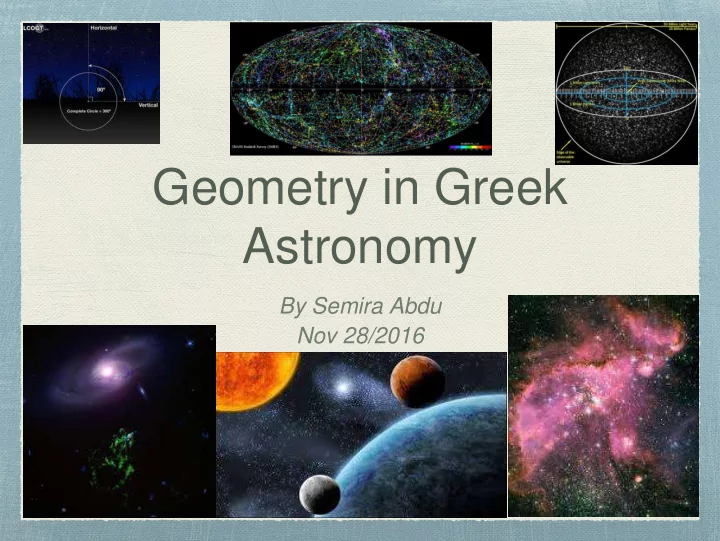

Geometry in Greek Astronomy By Semira Abdu Nov 28/2016
• Charted the stars and named the constellations • They Identified the 12 signs of Zodiac • They further partitioned each sign into 30 degrees so that the zodiac circle has 360 degrees • Their system of angular measure like degree, minutes and seconds still in use today • They also tracked the movement of the sun, the moon, and at least three of the five visible planets, Venus, Mars, and Jupiter. • Predicted Solar and Lunar eclipse
• Refined astronomy from being an observational science with an element prediction into a full blown theoretical science. • They understood the night sky like a map • To the Greeks the universe was a machine that ran upon mechanical and mathematical principles , which could be deduced through logic and reasoning
• The first notable Greek Philosopher and Astronomer • He successfully predicted an eclipse in 585 BCE • He is also credited with inventing trigonometry • From scattered records, it seems that he believed that the was flat.
• Better known for his idea about evolution, he was the first Greek philosopher to create a cosmological model. • He believes that the earth was cylindrical in shape
• He postulated that the earth was spherical • He suggested that the movement of the planets, sun , moon and stars could be described by whole numbers and mathematical precision.he also discovered that the morning and evening stars are the same things the planet Venus.
• He believed that the sun was a huge mass of blazing metal and the heavenly bodies were rock torn from the earth and set aflame by rapid rotation. • he believed the earth was flat • Heraclieds was the first to suggest the sun is the centre of the universe. A concept that would not be accepted until Copernicusn early 2000 years later • there two astronomers were a great influence on one of the most famous philosopher, Plato
• He believed that the entire cosmos was constructed with precision and that circles and spheres as the most perfect objects and that they were the key to understanding the universe. • He proposed that the stars, sun, and moon were fixed to concentric crystalline spheres rotating inside one another
• Aristarchus teacher of Archimedes was the first astronomer to make reasonable estimate of the distance of the sun and the moon for the earth. • he believed that the earth rotated about its axis • Dm/Rm=Ds/Rs=2pi/720 • sinθ=Rm/Rs Exam question Express Rm,Rs, and Ds in terms of θ and Dm
https://www.youtube.com/w atch?v=HEheh1BH34Q
* A Survey of classical and modern geometry, Arthur Banger,2011 * Ede, A. & Cormack, L.B. (2012). A History of Science in Society: From the Ancient Greeks to the Scientific Revolution, North York, Ontario, Canada: University of Toronto Press * Lloyd, G.E.R. (2006). Principles and Practices in Ancient Greek and Ancient Chinese Science. Aldershot, UK: Ashgate * Tuplin, C.J. & Rihill, T.E. (2002). Science and Mathematics in Ancient Greek Culture. Oxford, UK: Oxford University Press
Recommend
More recommend